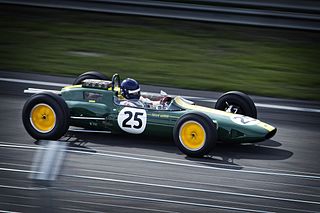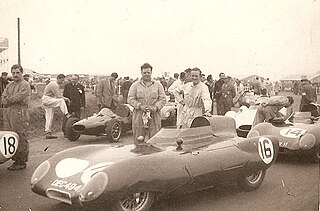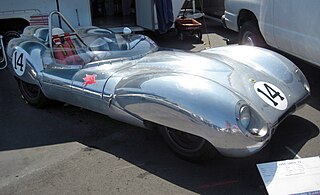
The Lotus Seven is a sports car produced by the British manufacturer Lotus Cars between 1957 and 1972. The Seven is an open-wheel car with two seats and an open top. It was designed by Lotus founder Colin Chapman and has been considered the embodiment of the Lotus philosophy of performance through low weight and simplicity. The original model was highly successful with more than 2,500 cars sold, due to its attraction as a road legal car that could be used for clubman racing.

The Lotus Elite name has been used for two production vehicles and one concept vehicle developed and manufactured by British automobile manufacturer Lotus Cars. The first generation Elite Type 14 was produced from 1957 until 1963 and the second generation model from 1974 until 1982. The Elite name was also applied to a concept vehicle unveiled in 2010.

Coventry Climax was a British forklift truck, fire pump, racing, and other speciality engine manufacturer.

Elva was a sports and racing car manufacturing company based in Bexhill, then Hastings and Rye, East Sussex, United Kingdom. The company was founded in 1955 by Frank G. Nichols. The name comes from the French phrase elle va.

The Lotus 17 was a sports car racing model built by Lotus Cars in 1959. Designed by Len Terry, it was built in response to the Lola Mk1 which was dominant against the previous Lotus model, the Eleven. It was replaced in 1960 by the Lotus 19.

Team Lotus was the motorsport sister company of English sports car manufacturer Lotus Cars. The team ran cars in many motorsport categories including Formula One, Formula Two, Formula Ford, Formula Junior, IndyCar, and sports car racing. More than ten years after its last race, Team Lotus remained one of the most successful racing teams of all time, winning seven Formula One Constructors' titles, six Drivers' Championships, and the Indianapolis 500 in the United States between 1962 and 1978. Under the direction of founder and chief designer Colin Chapman, Lotus was responsible for many innovative and experimental developments in critical motorsport, in both technical and commercial arenas.

The Lotus 25 was a racing car designed by Colin Chapman for the 1962 Formula One season. It was a revolutionary design, the first fully stressed monocoque chassis to appear in Formula One. In the hands of Jim Clark it took 14 World Championship Grand Prix wins and propelled him to his 1963 World Championship title. Its last World Championship win was at the 1965 French Grand Prix.

Turner Sports Car Company Limited was a 1950s British sports car manufacturer, that closed in 1966.

The Lotus Mark VI is the first production car by Lotus Cars. It was introduced by Colin Chapman in 1952 after previously building multiple trials and road racing cars. The heart of the Mark VI is a semi-space frame chassis. Rather than a complete car, it was available to the general public as kit, wherein the customer could install any preferred engine and gearbox, making it eligible for a wider number of formulae.

The TVR Grantura is the first production model in a long line of TVR cars. It debuted in 1958 and went through a series of developments leading to the Mark I to Mark IV and 1800S models. The last ones were made in September 1967.

The Lotus 18 was a race car designed by Colin Chapman for use by Lotus in Formula Junior, Formula Two, and Formula One.

The Lotus Eleven is a sports racing car built in various versions by Lotus from 1956 until 1958. The later versions built in 1958 are sometimes referred to as Lotus 13, although this was not an official designation. In total, about 270 Elevens of all versions were built.

The Lotus 23 was designed by Colin Chapman as a small-displacement sports racing car. Nominally a two-seater, it was purpose-built for FIA Group 4 racing in 1962–1963. Unlike its predecessors Lotus 15 and 17, the engine was mounted amidship behind the driver in the similar configuration developed on Lotus 19.

Bandini Automobili was an Italian automobile manufacturer operating between 1946 and 1992. It was named after its founder Ilario Bandini. It produced about 75 cars, of which around 40 were sold in the United States.

The Lotus Mark VIII car was Colin Chapman’s first fully enclosed aerodynamic design. Chapman's basic requirements for the design were for a car of 1100 lbs powered by an 85 bhp engine and a maximum speed of 125 mph. Work began on this design in late 1953 and Chapman was assisted in the design of the body by the aerodynamicist Frank Costin, who was the brother of Mike Costin, his main collaborator.

The Lotus 12 was a British racing car used in Formula Two and Formula One. It first debuted at the 1958 Monaco Grand Prix and was Colin Chapman's first single-seat racer.

The Lotus 16 was the second single-seat racing car designed by Colin Chapman, and was built by his Lotus Cars manufacturing company for the Team Lotus racing squad. The Lotus 16 was constructed to compete in both the Formula One and Formula Two categories, and was the first Lotus car to be constructed for Formula One competition. Its design carried over many technological features of the first Lotus single-seater, the Lotus 12, as well as incorporating ideas which Chapman had been developing while working on the Vanwall racing cars. Indeed, such was the visual similarity between the Vanwall and Lotus 16 designs that the Lotus was often dubbed the "mini Vanwall" by the contemporary motor sport press. Although the Lotus 16 only scored five Formula One World Championship points in the three seasons during which it was used, its raw pace pointed the way for its more successful successors, the Lotus 18 and 21.

John Crosthwaite was an English race car designer and engineer, active in both the United Kingdom and the United States.

The Lotus 15 is a front-engine sports racing car designed by Colin Chapman of Lotus, built from 1958 until 1960.

The Cooper T39, nicknamed the "Bob-Tail", is a successful lightweight, mid-engined, sports car, designed and developed by Owen Maddock at Cooper Cars, for sports car racing in 1955. The car debuted in active racing competition at the Easter race in Thruxton in 1955, being driven by Ivor Bueb, and was later entered into the 1955 24 Hours of Le Mans, being driven by John Brown and Edgar Wadsworth, but was unfortunately not classified, because even though the car managed to complete 207 laps around the 8.4-mile Le Mans circuit, it didn't manage to finish within 70% of the winners' race distance. However, between 1956 and 1962, it did manage to rack up and tally an incredible streak of domination and competitiveness, scoring 91 total wins and clinching 236 podiums finishes; an incredible record. It was powered by the 1,098 cc (67.0 cu in) Coventry-Climax four-cylinder engine.




















